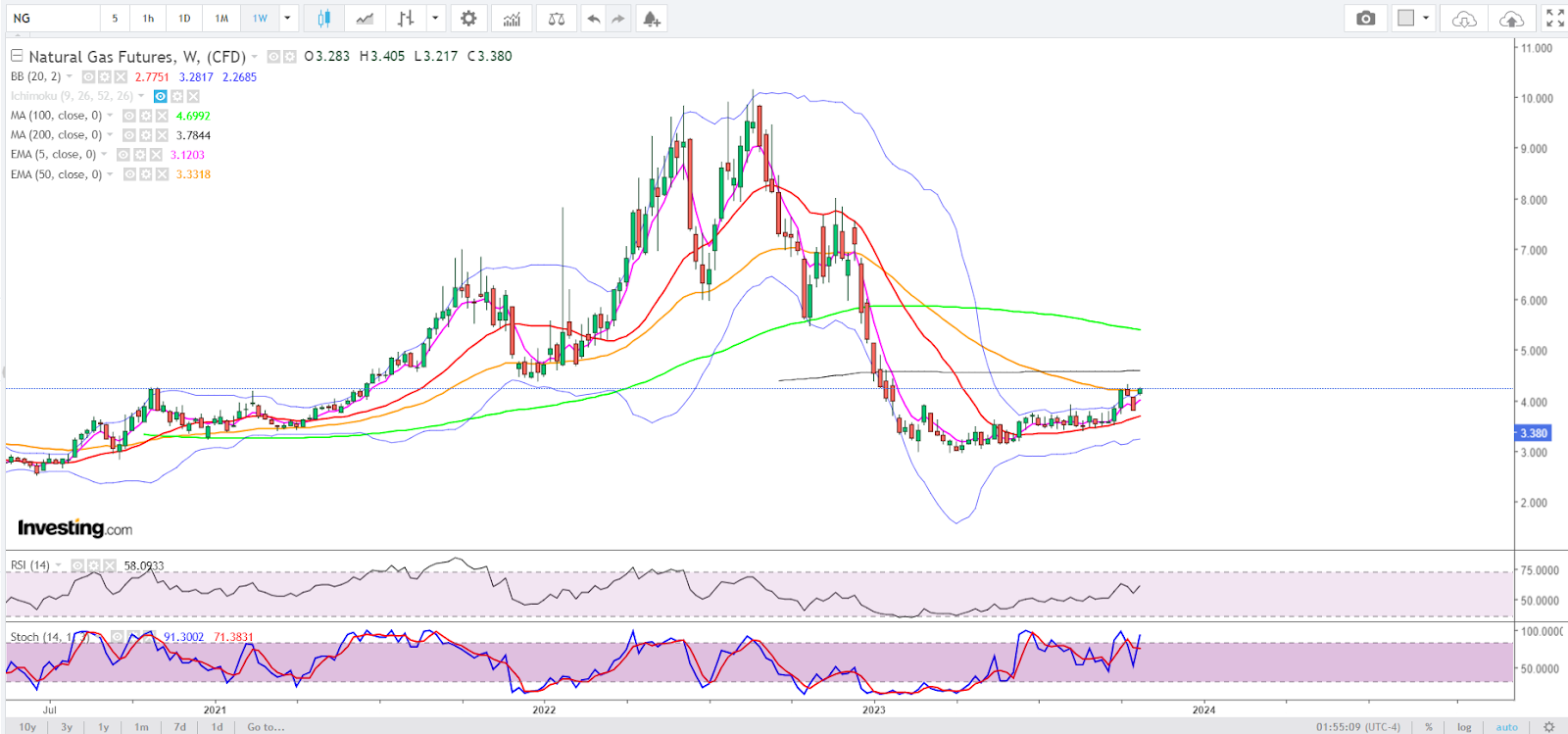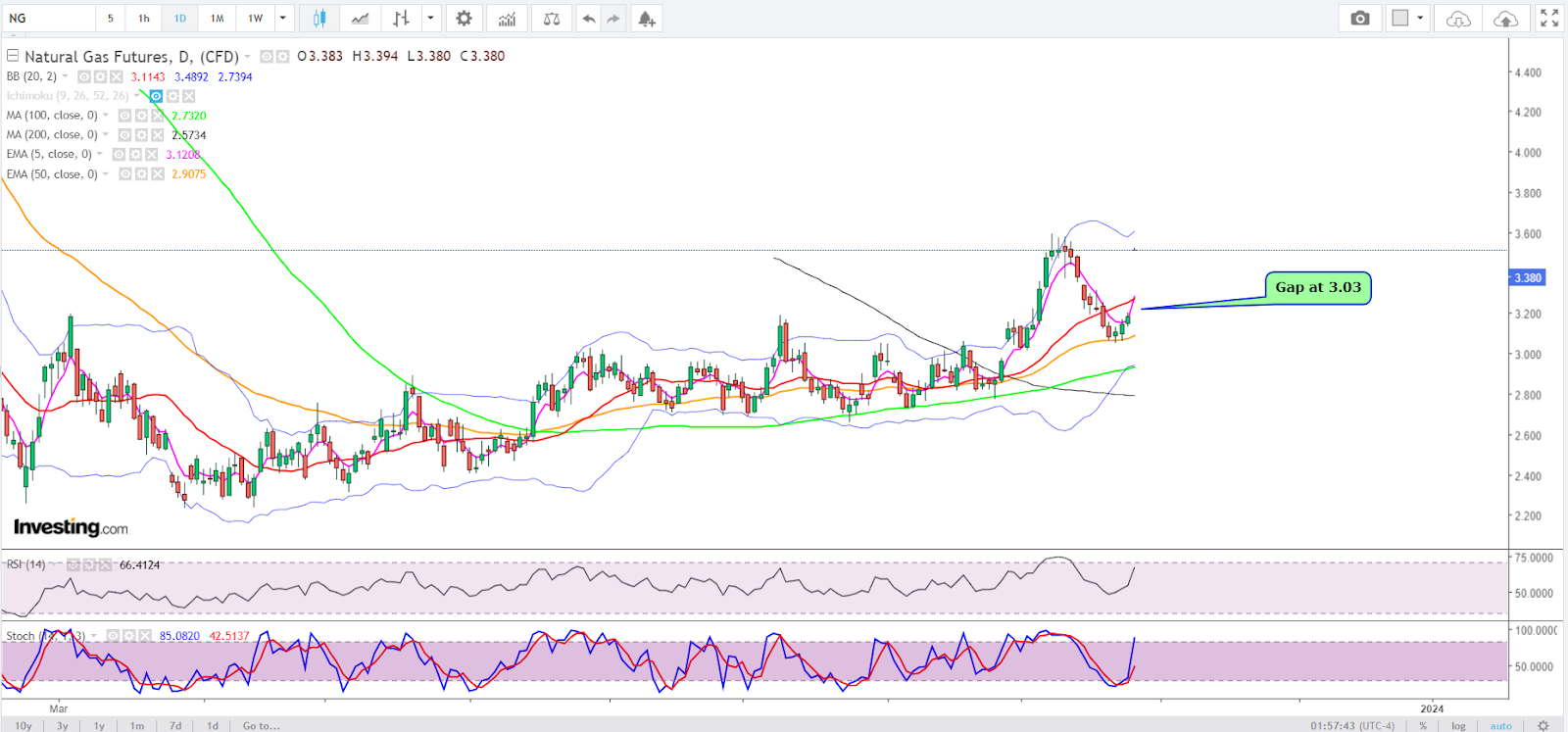Natural Gas Above $3 Requires Braving Record Output, UnHelpful Chart/Weather
2023.10.26 04:49
- Outsized storage build from last time a culmination of production at all-time highs of 103 bcf and weather being warmer-than-thought
- Upcoming storage report likely to show similar bcf increase, adding to bulls’ challenge
- Gas prices, however, rose 18% over 3 sessions as speculators defy output/weather trends
- Charts show prices can stay above $3 if gap before latest rebound is filled
After a kiss of death from overbearing production that almost returned US to mid-$2 pricing, the obverse kiss of life emerged from speculators this week to restore mid-$3 pricing.
For the love fest to continue, two things might be needed: leaner production and fulfillment of the trading gap that occurred before the comeback rally.
 Charts by SKCharting.com, with data powered by Investing.com
Charts by SKCharting.com, with data powered by Investing.com
Until August came along, the year has been one of the most maddening ones for gas bulls, who get up each time to get squashed again by record production, often benign weather that needs neither heating or cooling and spotty export demand for liquefied natural gas, or LNG.
The sum effect of all these, of course, is a stockpile overhang running double-digits higher than a year ago and looking impossible to clear right away.
Yet, like the skies opening up after a storm, things suddenly began to brighten up for gas longs: Production started tapering, the volume of gas burned for power generation became consistent, LNG takeup improved and gas in storage started melting.
Last week though, the horrors of the past were revisited on the gas market — some two weeks earlier than Halloween actually.
The jolt came in the form of the government’s on gas for the week ended Oct. 13 that came in at 17 billion cubic feet, or bcf, higher than the forecast level of 80.
In the words of John Sodergreen — who authors another trade publication on gas called ‘The Desk’, “last week’s monster 97-Bcf build caught just about everybody by surprise, and rightly so.” He adds:
“After the 97-bcf surprise last week, this week looks like another coin toss. Odds are this week’s report comes in way lower than the survey, though for all the wrong reasons.
“Recall, too, that East, Midwest and mountain storage facilities are all pretty darn full right now. The south-central is the only place left that can handle any substantial builds. And weather-driven demand last week wasn’t exactly stout anywhere. Production was solid, too. This is another reason the south-central saw such a monster build last week – gas simply needed a home anywhere.”
Today’s gas storage report from the Energy Information Administration, or EIA, for the week ended Oct. 20 is likely to show that US utilities likely added another 80 bcf. That would be higher than the 61 bcf injected during the same week a year ago and the five-year (2018-2022) average increase of 66 bcf for this time of year.
Sodergreen makes another point gas bulls probably won’t be thrilled with — it’s going to get warmer just when the weather should be getting steadily colder.
“October is expected to be inside the top 10 warmest since 1950, and November is looking similarly mild, so maybe we actually see the injection season carry through to December this year. End of season getting easily back over 3.8 tcf is suddenly looking like a gimme.”
Storage totaled 3.626 tcf, or trillion cubic feet, last week. That was 9% higher than a year ago and 5.1% on the five-year (2018-2022) average.
To be fair, both the annual and five-year averages were up double-digits just months ago.
But at the rate production is building again — at record highs of more than 103 bcf per day — storage levels are likely to blow out again.
Eli Rubin of EBW Analytics reports that the immediate term outlook suggests a deeper test of support favors widespread warmth, softening LNG and production continuing to show strength as rising Appalachian output offsets retreating Permian and Haynesville supplies.
There were 65 total degree days, or TDDs, last week compared with a 30-year normal of 75 TDDs for the period, weather data showes.
TDDs measure the number of degrees a day’s average temperature is above or below 65 degrees Fahrenheit (18 Celsius) to estimate demand to cool or heat homes and businesses.
Still, Rubin offers some hope to the bulls.
“The deepening cold across the northern US into early November could add more than 14 Bcf/d of daily demand from last Thursday’s nadir to the Nov. 1 peak. Physical markets could tighten, rapidly helping NYMEX futures to find a short-term bottom.”
That short-term bottom, when it emerges, would be an intriguing given that gas futures on the NYMEX’s Henry Hub are again stretching mid-$3 levels on a speculative run that has to be matched by both fundamental drivers and technical support.
From a low of $2.861 on Oct. 23, the front-month contract on the Henry Hub surged to $3.376 by the close of Oct. 25 — a phenomenal leap of 51.5 cents, or 18%, over just three sessions.
 Sunil Kumar Dixit, chief technical strategist at SKCharting and a regular collaborator on commodities charting with Investing.com, points out the technical challenges that lay ahead for the bulls:
Sunil Kumar Dixit, chief technical strategist at SKCharting and a regular collaborator on commodities charting with Investing.com, points out the technical challenges that lay ahead for the bulls:
“The current bullish momentum leaves a runaway gap at $3.03.That calls for an eventual pull back to the Daily Middle Bollinger Band of $3.11, followed by $3.03 if the gap isn’t filled.”
A gap is an area discontinuity in a chart where its price either rises or falls from the previous day’s close with no trading occurring in between. Gaps are common when news causes market fundamentals to change during hours when markets are typically closed, for instance an earnings call after-hours.
If the gap does get closed, then things look brighter on the technical front as well for gas, says Dixit.
“Stability above the 50-week EMA, or Exponential Moving Average, of $3.33 is a sign of strength for further upside, toward the next leg higher at the 200-week SMA, or Simple Moving Average, of $3.78.”
***
Disclaimer: The aim of this article is purely to inform and does not in any way represent an inducement or recommendation to buy or sell any commodity or its related securities. The author Barani Krishnan does not hold a position in the commodities and securities he writes about. He typically uses a range of views outside his own to bring diversity to his analysis of any market. For neutrality, he sometimes presents contrarian views and market variables.






